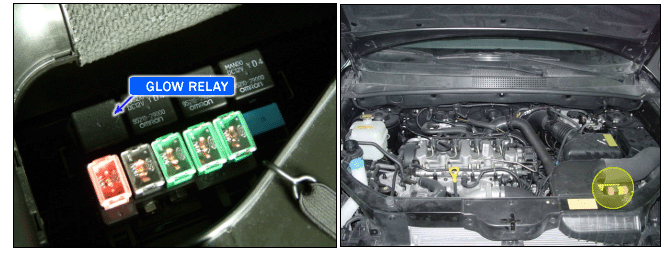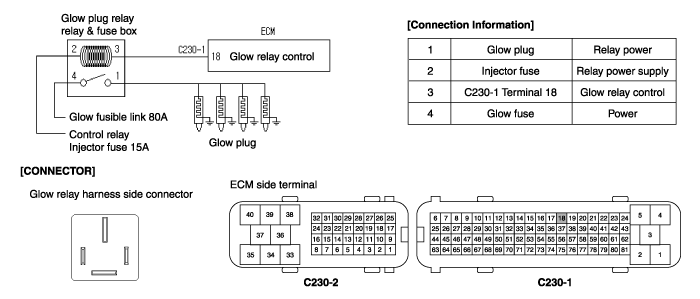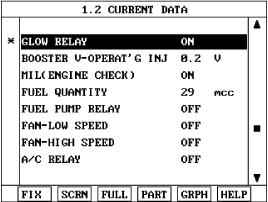Has a problem been found?

Repair as necessary and go to "Verification of Vehicle Repair" procedure.

Go to " Power Circuit Inspection " procedure.

The golw plugs are used to heat the inlet air and able to start the engine.
This heating is necessary to allow the diesel fuel to ignite when the temperature low.
The ECM controls the feed to preheating resistor via one relay.
When the ignition switch is turned on, applies the battery voltage from the heater fuse to the ECM.
The glow plug relay coil is energized to turn on the relay switch, which activates the glow plugs by the ECM, according to the signal of water temperature sensor. Feed faults are diagnosed by the ECM via the lines connected to the control terminal of the heater relay. The duration of preheating and illumination of glow indicator lamp are entirely controlled by the injection computer depending on the engine operating conditions.
In case of the glow plug relay failure, the engine symptoms will occur the glow plugs deactivation and the engine starting delayed during the cold condition.
If the signal exceeds threshold value, the ECM judged this as a fault and DTC is set.
Item | Detecting Condition | Possible Cause |
DTC Strategy | ● Circuit continuity check | ● Open or short to ground in power circuit ● Short to ground in control circuit ● Open in control circuit ● Faulty relay ● Faulty ECM |
Enable Conditions | ● Ignition on | |
Threshold Value | ● Short for glow relay control circuit | |
Diagnostic Time | ● 1 sec. | |
MIL Fuel Limit Fuel Cut EGR Off | ● No ● No ● No ● No | |
Fail safe | ● Engine speed is fixed as 1200 rpm without the accel position sensor action. |


Connect scantool to Data Link Cable (DLC).
Monitor " Glow Relay " parameter on the scantool.

Fig 1) Glow relay ON after the ignition switch ON before coming to the coolant temperature 60°C.
Is the Current data displayed correctly ?

▶ Fault is intermittent caused by poor contact in the sensor’s and/or ECM’s connector or was repaired and ECM memory was not cleared. Thoroughly check connectors for looseness, poor connection, bending, corrosion, contamination, deterioration, or damage. Repair or replace as necessary and go to "Verification of Vehicle Repair" procedure .

▶ Go to "W/Harness Inspection" procedure.
Many malfunctions in the electrical system are caused by poor harness and terminals.
Faults can also be caused by interference from other electrical systems, and mechanical or chemical damage.
Thoroughly check connectors for looseness, poor connection, bending, corrosion, contamination, deterioration, or damage.
Has a problem been found?

Repair as necessary and go to "Verification of Vehicle Repair" procedure.

Go to " Power Circuit Inspection " procedure.
Ignition "OFF" & Engine "OFF".
Disconnect Glow relay.
Ignition "ON" & Engine "OFF".
Measure voltage between terminal 4 of the relay harness connector and chassis ground.
Measure voltage between terminal 2 of the relay harness connector and chassis ground.
Specification : Approx. B+

Is the measured voltage within specifications ?

▶ Go to " Control Circuit Inspection" procedure.

▶ Check for short to battery in power harness.
Repair as necessary and go to "Verification of Vehicle Repair" procedure.
Check for short to ground in harness.
Ignition "OFF" & Engine "OFF".
Disconnect Glow relay.
Measure voltage between terminal 3 of the glow relay connector and chassis ground.
Specification : Infinite

Is the measured resistance within specifications ?

▶ Go to " Check for open in harness " as below

▶ Check for short to ground in harness.
Repair as necessary and go to "Verification of Vehicle Repair" procedure.
Check for open in harness.
Ignition "OFF" & Engine "OFF".
Disconnect Glow relay.
Measure resistance between terminal 3 of the glow relay connector and terminal 18 of ECM harness connector.

Is the measured resistance within specifications ?

▶ Go to " Component Inspection " procedure.

▶ Check for open in control harness.
Repair as necessary and go to "Verification of Vehicle Repair" procedure.
Check Glow relay.
Ignition "OFF" & Engine "OFF".
Disconnect Glow relay.
Measure resistance between terminal 2 and 3 of glow relay.
Specification : 55 ± 5Ω

Is the measured resistance within specifications ?

▶ Go to "Check Glow relay operation" as below.

▶ Substitute with a known-good ECM and check for proper operation.
If the problem is corrected, replace ECM and then go to "Verification of Vehicle Repair" procedure.
Check Glow relay operation.
Ignition "OFF" & Engine "OFF".
Connect Glow relay and Disconnect ECM connector.
Connect volt meter or test lamp with Glow plug connector (C206).
Ignition "ON".
Energize Glow relay by grounding terminal 18 of ECM harness connector or Select actuator test with scantool for operating glow relay.
Time to operate glow relay should not be over than 3 sec.
Because glow plug can be damaged or Battery can be discharged.
Is the glow relay operating correctly ?

▶ Thoroughly check connectors for looseness, poor connection, bending, corrosion, contamination, deterioration, or damage. Repair or replace as necessary and go to "Verification of Vehicle Repair" procedure.

▶ Substitute with a known-good ECM and check for proper operation.
If the problem is corrected, replace ECM and then go to "Verification of Vehicle Repair" procedure.
After a repair, it is essential to verify that the fault has been corrected.
Connect scan tool and select "Diagnostic Trouble Codes(DTCs)" mode and then clear DTC.
Operate the vehicle within DTC Enable conditions in General information.
Are any DTCs present ?

Go to the applicable troubleshooting procedure.

System is performing to specification at this time.